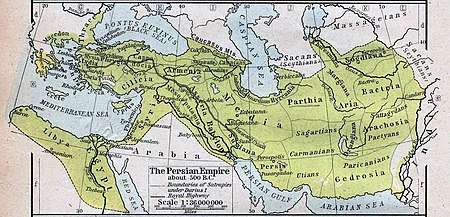Amardi
The Amardians, widely referred to as the Amardi (and sometimes Mardi), were an ancient Iranian[1] tribe living along the mountainous region bordering the Caspian Sea to the north,[2][3][4] to whom the Iron Age culture at Marlik is attributed.[5] They are said to be related to, or the same tribe as, the Dahae and Sacae. That is to say, they were Scythian.[6] Herodotus mentions a tribe with a similar name as one of the ten to fifteen Persian tribes in Persis.[1][7] They lived in the valleys in between the Susis and Persis,[8] in what in now southwestern Iran. The southern Mardi are described by Nearchus as one of the four predatory mountain peoples of the southwest, along with the Susians, Uxii, and Elymaeans.[9] Of these four nomadic groups, they were the only tribe linguistically Iranian.[10]
| Part of a series on the History of Tabaristan |
|---|
|
Prehistoric archaeology
|
|
Early Sasanian houses |
|
Last Sasanian rulers
|
|
Early Shia rulers
|
|
Modern period |
|
|
Etymology
The term Mardi comes from the Old Iranian word for "man"[8] (Old Persian: 𐎶𐎼𐎫𐎡𐎹 martiya; from Proto-Indo-European *mr̥tós, "mortal").
Richard N. Frye believe that the name of the city of Amol is rooted in the word Amard, which occurs as Amui in Middle Persian[11]. According to historical literature, Amol was the capital of Tapuria (modern-day Mazanderan), at least in the period starting from the Sasanian Empire to the Ilkhanate of the Mongol Empire.
Historical accounts
Strabo mentions the name Mardi several times. He places their location to the south of the Caspian Sea in what is now Gilan and Mazanderan, in northern Iran.[5][12] On his map, he mentions Amardos (and the Amardos river), the name attributed to the region of Sefidrud at the time.[5][13][14]
Herodotus mentions a tribe with a similar name as one of the ten to fifteen Persian tribes in Persis.[1][7] They lived in the valleys in between the Susis and Persis,[15] in what in now southwestern Iran. The southern Mardi are described by Nearchus as one of the four predatory mountain peoples of the southwest, along with the Susians, Uxii, and Elymaeans.[16] Of these four nomadic groups, they were the only tribe linguistically Iranian.[17]
Gallery
 Map of the Median Empire (600 BC), showing the relative locations of the Amardian tribe.
Map of the Median Empire (600 BC), showing the relative locations of the Amardian tribe. The Amardian satrap shown within a map of the Achaemenid Empire at its greatest extent (500 BC).
The Amardian satrap shown within a map of the Achaemenid Empire at its greatest extent (500 BC).

See also
References
- "IRAN" [v. PEOPLES OF IRAN (2) Pre-Islamic]. Encyclopædia Iranica. XIII. Retrieved July 20, 2017.
- Compact Bible atlas with gazetteer. Baker Book House. 1979. p. 7.
- Smith, William (1854). Dictionary of Greek and Roman Geography. 1. Little, Brown & Company.
- Indo-iranica. 2. Iran Society. p. 21.
- Negahban, Ezat O. (1995). Marlik: The Complete Excavation Report. UPenn Museum of Archaeology. p. 321.
- Norris, Edwin (1853). Memoir on the Scythic Version of the Behistun Inscription. Harrison and Sons.
- "Encyclopaedia Iranica". Encyclopædia Iranica. 13. Routledge & Kegan Paul. 2004. p. 336. Retrieved May 21, 2020.
- Eadie, John (1852). Early Oriental History, Comprising the Histories of Egypt, Assyria, Persia, Lydia, Phrygia, and Phoenicia. Griffin.
- "CASPIANS". Encyclopædia Iranica. V. p. 62. Retrieved July 20, 2017.
- electricpulp.com. "IRAN v. PEOPLES OF IRAN (2) Pre-Islamic – Encyclopaedia Iranica". www.iranicaonline.org. Retrieved 2017-08-07.
- Richard N. Frye. "Ancient Central Asian History Notes". Proceedings of the Second European Congress of Iranian Studies. Rome: ISMEO. p. 188.
town of Amul on the Amu Darya and the Amul in Mazanderan, Iran, both of which may be traced back to the migration of an Iranian tribe called Amardi or Mardi
- "CASPIANS". Encyclopædia Iranica. V. p. 62. Retrieved July 20, 2017.
- "GĪLĀN" [iv. History in the Early Islamic Period]. Encyclopædia Iranica. X. pp. 634–635. Retrieved July 20, 2017.
- Wright, John Henry (1905). A history of all nations from the earliest times. Lea Brothers.
- Eadie, John (1852). Early Oriental History, Comprising the Histories of Egypt, Assyria, Persia, Lydia, Phrygia, and Phoenicia. Griffin. p. 276.
mardi.
- "CASPIANS". Encyclopædia Iranica. V. p. 62. Retrieved July 20, 2017.
- electricpulp.com. "IRAN v. PEOPLES OF IRAN (2) Pre-Islamic – Encyclopaedia Iranica". www.iranicaonline.org. Retrieved 2017-08-07.